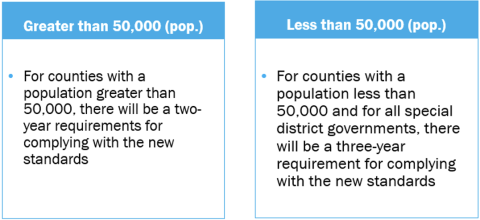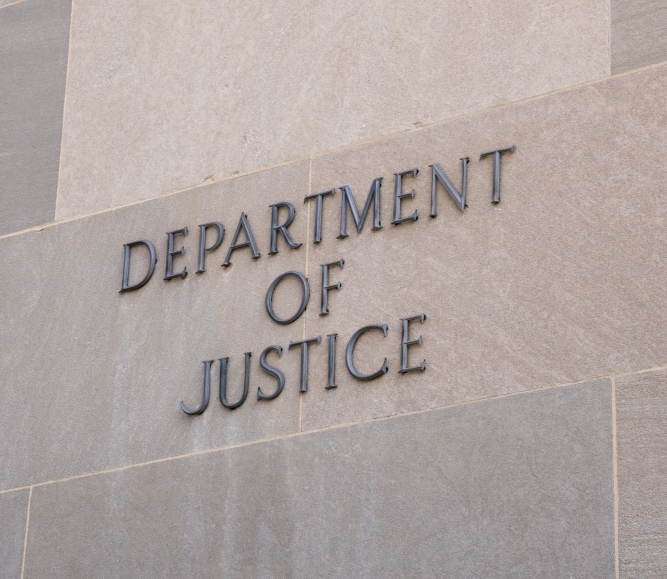NACo Analysis: U.S. Department of Justice Final Rule on Web Accessibility for State and Local Governments

Upcoming Events
Related News
Key Highlights of the Final Rule
- Counties will be required to comply with the Final Rule’s web accessibility technical standards within a 2-3 year timeline
- Goal of the Final Rule is to promote accessibility of online government services and resources in concert with the Americans with Disabilities Act (ADA)
- Covered content includes all text, video, audio, website layout and design, future social media posts, and documents hosted on the county’s website
- Limited exceptions include third party content, archived documents and pre-existing social media
Introduction
Key Highlights of the Final Rule
- Counties will be required to comply with the Final Rule’s web accessibility technical standards within a 2-3 year timeline
- Goal of the Final Rule is to promote accessibility of online government services and resources in concert with the Americans with Disabilities Act (ADA)
- Covered content includes all text, video, audio, website layout and design, future social media posts, and documents hosted on the county’s website
- Limited exceptions include third party content, archived documents, and pre-existing social media
Watch: NACo Overview of the U.S. Department of Justice Final Rule on Web Accessibility for State and Local Governments
Download Slides | Watch in New Window
Do you have further questions about the US. Department of Justice’s (DOJ) Final Rule? Contact the DOJ’s ADA Info Line at 800-514-0301 (voice) and 1-833-610-1264 (TTY). You may also send questions for the DOJ to NACo staff at sdowdall@naco.org.
Compliance Timelines

What web content is covered under the Final Rule?
DOJ defines web content as content provided or made available, directly or through contractual, licensing, or other arrangements, that is readily accessible to and usable by individuals with disabilities. This includes text, images, sounds, videos, controls, animations and conventional electronic documents.
Web content covered under the Final Rule includes:
- County information on a website and/or mobile application(s)
- Services offered on a website and/or mobile application(s)
- Social media posts on third-party platforms
- Third-party tools and resources hosted on a county’s website
- County services offered through a third party platform
The Web Content Accessibility Guidelines (WCAG) 2.1, published in June 2018, will be the basis for compliance. The WCAG 2.1 Level AA Success criteria and conformance requirements will be mandatory for compliance.
What is exempt from compliance?
The following content is exempt from compliance:
- Archived web content that:
- Was created before the date the required compliance date
- Reproduces paper documents created before the required compliance date
- Reproduces the contents of other physical media created before the required compliance date
- Is retained exclusively for reference, research or recordkeeping
- Is not altered or updated after the date of archiving
- Is organized and stored in a dedicated area or areas clearly identified as being archived
A county is still obligated to make archived content accessible on a case-by-case basis in relation to existing Title II obligations.
Example: If an individual requests an accessible copy of a partial recording of a commissioners’ meeting, the county would be required to provide an accessible format.
Pre-existing conventional electronic documents (unless such documents are currently used to apply for, gain access to or participate in the county’s services, programs or activities)
Conventional electronic documents are web content or content in mobile apps that are in the following electronic file formats:
- Portable document formats (“PDF”)
- Word processor file formats
- Presentation file formats
- Spreadsheet file formats
Example: If a county moves all files to a new Content Management System, without editing files uploaded prior to the compliance date in the above formats, they would still be considered excepted.
If edits were made to the documents, or if they are considered actively a part of a county’s activities, programs or services, they would be considered covered by the rule.
Content posted by a third party, (unless the third party is posting due to contractual, licensing or other arrangements with the county)
Third party content can include or link to many different types of content created by someone other than the public entity, some of which is posted by or on behalf of public entities and some of which is not.
Content posted by third parties on a county’s website can be accepted if it does not pertain to any affiliation, or contractual or licensed arrangement, with the county.
Example: Courts receive a high volume of document submissions annually, often by third parties unaffiliated with the county. Such documents do not need to be accessible upon submission as a requirement; however, counties must still meet existing Title II obligations.
Conventional electronic documents about a specific individual, their property or their account (and that are password-protected or otherwise secured)
Conventional electronic documents are digital documents that are about a specific individual, their property or their account and that are password protected or otherwise secure.
Example: Many utilities may offer password account access to individual utility bills. Public hospitals may also offer a virtual platform where healthcare providers can send conventional electronic documents of test results to patients.
These documents are excepted from compliance to the extent that such compliance would be overly burdensome. The need can be better addressed through existing Title II obligations, including to make accessible by request such documents by the individual who needs them.
Pre-existing social media posts, which include any social media posts that were posted by the county before the effective compliance date imposed by the Final Rule.
Example: The county hosts a parade every year, and past social media posts include photographs from the parade and other then-current information. The county would not be required to retroactively make these posts accessible.
Social media posts going forward after the date of compliance will be required to use the full suite of accessibility resources. The public entity will be required to make accessible all social media posts to the greatest extent possible provided by the medium.
Please Note: This may not preclude a county from needing to make accessible any piece of content if requested by a specific individual to comply with the entity’s existing obligations under other regulatory provisions implementing Title II of the ADA.
Section-by-Section Analysis
Beginning on April 24, 2026 (for a population greater than 50,000) or April 24, 2027 (for a population less than 50,000), compliance with the WCAG 2.1 Level A and Level AA standards will be required
Success criteria for WCAG 2.1 broadly includes four main categories:
- Perceivable (i.e. text alternatives, time-based media, adaptable and distinguishable)
- Operable (i.e. keyboard accessible, “enough time”, seizures and physical reactions, navigable and input modalities)
- Understandable (i.e. readable, predictable, input assistance)
- Robust (i.e. compatible)
Exceptions to the previous section (Sec. 35.200) include:
- Archived web content
- Pre-existing conventional electronic documents (unless the documents are used to apply for, gain access to, or participate in the public entity’s services, programs or activities)
- Content posted by a third party (unless the third party is posting due to contractual, licensing or other arrangements with the public entity)
- Individualized, password-protected or otherwise secure conventional electronic documents, which can include documents that are:
- About a specific individual, their property or their account
- Password-protected or otherwise secured
- Pre-existing social media posts that were posted before the date the public entity is required to comply with this rule
A conforming alternate version is a separate version of web content that is accessible, up to date, contains the same information and functionality as the inaccessible web content and can be reached in particular ways, such as through a conforming page or an accessibility-supported mechanism.
This alternative is only permitted when it is not possible to make web content directly accessible due to technical or legal limitations.
The final rule allows a public entity flexibility to show that its use of other designs, methods or techniques as alternatives to WCAG 2.1 Level AA provides substantially equivalent or greater accessibility and usability of the web content or mobile app. However, the final rule does not prohibit an entity from going above and beyond the minimum accessibility standards this rule sets out.
However, a 24/7 staffed telephone line for services is not a permitted conforming alternate version, per regulatory guidance from 2022.
A conforming alternate version is a separate version of web content that is accessible, up to date, contains the same information and functionality as the inaccessible web content and can be reached in particular ways, such as through a conforming page or an accessibility-supported mechanism.
This alternative is only permitted when it is not possible to make web content directly accessible due to technical or legal limitations.
The final rule allows a public entity flexibility to show that its use of other designs, methods or techniques as alternatives to WCAG 2.1 Level AA provides substantially equivalent or greater accessibility and usability of the web content or mobile app. However, the final rule does not prohibit an entity from going above and beyond the minimum accessibility standards this rule sets out.
However, a 24/7 staffed telephone line for services is not a permitted conforming alternate version, per regulatory guidance from 2022.
If following the guidance in the Final Rule would drastically change a service, program or activity or cause excessive financial and administrative burdens for a public entity, they must comply with the Final Rule to the extent that it does not cause such changes or burdens.
If the public entity believes that complying with the Final Rule would fundamentally change the service, program or activity or cause excessive financial and administrative burdens, they must prove it. The decision must be made by the head of the public entity (or their representative), considering all available resources, and must be explained in writing.
If complying with the Final Rule would cause such changes or burdens, the public entity must find another way to provide benefits or services to individuals with disabilities to the greatest extent possible.
A public entity that is not in full compliance with the requirements of the Final Rule will be deemed to have met the requirements in the limited circumstance in which the public entity can demonstrate that the noncompliance has such a minimal impact on access that it would not affect the ability of individuals with disabilities to use the public entity’s web content or mobile app.
This includes:
- Accessing the same information as individuals without disabilities
- Engaging in the same interactions as individuals without disabilities
- Conducting the same transactions as individuals without disabilities, and
- Otherwise participating in or benefiting from the same services, programs and activities as individuals without disabilities
Implementation and Next Steps
To begin the implementation process to comply with the Final Rule, NACo encourages county officials and staff to:
- Survey all departments and create an internal asset map of existing and new services offered online directly, or through contractual or licensing arrangements, to the public
- Add language to proposed contracts, bids and products specifications referencing required adherence to the WCAG 2.1 Level AA standard
- Review existing assets and audit for compliance to accessibility – develop a strategy for improving accessibility in the near term and assess cost to the county
- Develop an inventory of all public-facing applications and services and test them for compliance
- Consider resource development and staff training devoted to the new accessibility guidelines
- Start checking your compliance level now
Frequently Asked Questions for Counties
Disclaimer: The FAQs listed below were developed by NACo staff and are not included in the Final Rule or provided by the U.S. Department of Justice.
You can access the guidance here. Note: The DOJ opted to utilize the 2018 recommendation as the foundation of the current Final Rule. This may change in the future, but for purposes of immediate compliance, the September 2023 is not the standard to follow.
Explore accessibility scanner tools such as CivicPlus, Site Improve, AudioEye, WebAIM and built-in tools with existing enterprise products (such as Microsoft)**. The W3C also offers a list of developer tools here.
**NACo does not endorse any individual vendor or guarantee the outcome of interacting with their products
Survey all county departments for self-hosted resources and websites as well as contractual or licensed content made available by third parties.
As a best practice, contact any vendor in which you have an existing relationship to determine their web accessibility standard. Other vendors will post their standards on their website.
There are highly informational YouTube videos offered by the W3C community, which you can find here.
We are posing this question to the DOJ and will share the reply that we receive. If you utilize Esri, consult their accessibility conformance reports here.
Web content that a county makes available on a social media website, beginning after the date in which compliance is required (2 years for large public entities; 3 years for small public entities) is covered by this rule. Counties must use available accessibility features on all social media posts, and a conforming alternative on the county’s website is not sufficient to meet this need.
Platforms that provide live-audio captioning, such as Zoom, can reliably meet the success criteria. Additional vendors of real-time virtual presentation media should be vetted to ensure similar compliance standards.
Advocacy
DOJ issues final rule for state and local governments to implement web-based accessibility standards
On April 8, the U.S. Department of Justice (DOJ) announced the release of a web accessibility final rule for state and local governments.

Related News

House committee passes local broadband permitting preemption bills
The American Broadband Deployment Act of 2025 would enact new restrictions on a variety of state and local land use and zoning authorities pertaining to the deployment of telecommunications infrastructure.

White House signs Executive Order on state AI lawmaking
President Trump signed an Executive Order (EO) aimed at mobilizing federal agencies to challenge existing state laws on artificial intelligence.
